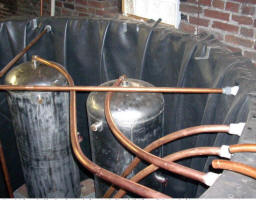
Search
The Renewable Energy site for Do-It-Yourselfers
Large Thermal
Storage Tank with Immersed Tank Heat Exchanger
|

This is a simple and elegant
thermal storage tank and heat exchanger installation from Alan Rushforth
of Rushforth
Solar LLC.
Thanks very much to Alan for
providing this material!
The tank provides thermal storage for
a large solar domestic water heating system in a 22 unit apartment building.
|
|
The 2000 gallon storage tank is 7 ft
high and 8 ft - 3 inches in diameter. It is made from a roll of 0.058 inch
thick sheet aluminum. The tank is just sheet metal wrapped into a cylinder
with the ends overlapped and fastened together. This is an efficient
design for a water tank, in that the water pressure loads are taken by simple
tension in the cylinder wall -- there are no bending loads in the tank wall.
The tank is insulated with 2 layers
of 1.5 inch rigid foam
board insulation on the inside and bottom of the cylinder. The insulation
is polyisocyanurate with aluminum foil face sheets. The tank is then lined with sheet EPDM. The EPDM liner is a single piece that
is just tucked and folded to fit the shape of the cylinder.
This is a drain back system, and the
tank is vented to the atmosphere (not pressurized). When there is
enough sun, water is pumped from the tank and up to solar collectors mounted on
the roof. The heated water is returned to the storage tank. Note the
two pumps that are connected in series to pump the water from the basement all
the way up to the roof.
The water to be heated for the people
in the apartment flows through the two stainless steel tanks that are immersed
in the large tank. Heat is transferred from the storage tank water to the
potable water by conduction through the stainless steel tank walls. This
preheats the water before it goes to the conventional water heater for the
apartment. The stainless tanks are about 50 gallons each.
During periods of low demand, the water in the immersed tank heats up to the
full temperature of the storage tank water, and provides some storage of
preheated water to satisfy high demands. If the preheated water is not hot
enough for final use, the conventional water heater will take it up to
temperature.
Note that all plumbing connections
are made above the waterline in the storage tank, so there are no penetrations
of the liner below the waterline that might leak later. The "U"
shaped loop that goes down the side of the tank to the two pumps, and then back
up to the output line to the collectors insures that the pumps retain their
prime.
The immersed tanks appear to be doing
a good job -- see the performance plot below.
So, this shows two nice ideas:
-
The simple metal hoop cylindrical
tank lined with EPDM. This is an efficient and relatively easy to make
tank. It provides a lot of storage at a reasonable price.
-
The use of a small tank(s)
immersed in a large tank to act as a simple heat exchanger.
You probably don't need an
installation this large for your house, but it can be scaled down appropriately
to your water or space heating needs.
Another variation on this theme would
be to use a large coil of PEX or even HDPE pipe in place of the immersed tank
for the heat exchanger. An immersed 300 ft coil of 1 inch pipe would hold
12 gallons of water, and even when the 12 gallons was exhausted, it would have
enough surface area to act as a pretty good heat exchanger.
All of these immersed tanks or pipe
coil schemes are single wall heat exchangers, so the fluid on the outside of the
exchanger tank must be non-toxic, and you should check with your local code
folks to make sure this arrangement is legal in your area.
From Alan:
"I am pretty pleased with the
performance of the immersed tanks. Two of them (100 gallons total) works
pretty well. Three would been a bit better. After that - diminishing
returns. I am still thinking about using galvanized tanks for that - maybe
fed by pex/al/pex to minimize galvanic action."

The Alan made 2000 gallon thermal storage tank.

The two stainless steel heat
exchanger tanks mounted inside the thermal storage tank.
Performance:

Note that even with a 22 unit
building, the "preheat out" temperature never falls far below the "Tank Top"
temperature.
Alan Rushforth
Rushforth Solar LLC
www.RushforthSolar.com
AR@RushforthSolar.com
Bryn Mawr, PA
Gary April 25, 2008




